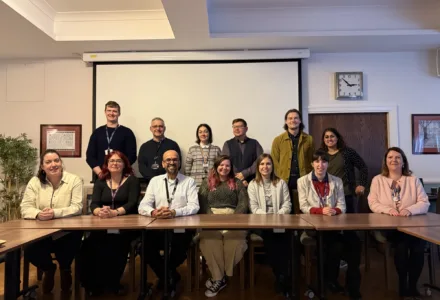ROMAN PERIOD
Excavations in the summer of 2018 by Bishop Grosseteste Archaeology Fieldschool identified the remains of a Roman building in the front garden of LORIC. Fronting onto Ermine Street, the structure was likely occupied by a trader specialising in the production of metalwork. A burial was found under one of the thresholds of a building, a common occurrence in the Roman period, which may have acted as a good luck or protective offering.
A SACRED SITE (1270-1530)
A friary of the Augustinian or ‘Austin’ Order was established under royal protection in 1270. Archaeological excavation has located Medieval and later remains at the rear of LORIC, probably representing parts the friary and the succeeding post-medieval property. The friary lay on the edge of a marketplace known as Newport Green, which specialised in selling Lincoln cloth. It was much wider than the modern road of Newport and would have extended right up to the front door of LORIC. Bishop Oliver Sutton (Bishop of Lincoln, 1280-1299) obtained licence to have the site consecrated in 1291. Around thirty friars lived on the site until 1530.
FRIARY LOST TO TIME AND NEWPORT HOUSE EMERGES (1530-1800)
Richard Yngworth (Bishop of Dover 1536-1545) received the surrender of the friaries in 1538. At that time, the site was described as “poor houses, nothing being left but stones and poor glass, but meetly leaded”. In 1540 the site, which amounted to about four acres, was let to Robert Dighton, at a rent of 12 shillings a year. In 1643 the buildings on the site were pulled down to prevent Royalists using the buildings as cover, and the stones from the buildings were used to help fortify the city walls. Although little is known about its origin or ownership, the earliest mention of Newport house (1798) can be found in the parish records of St. Nicholas church, which is a mere 100 yards from the site.
A PLACE OF LEARNING AND A FIRST CONNECTION TO BISHOP GROSSETESTE UNIVERSITY
Rev. George Rigg lived in Newport House from 1830 to 1840, running a school to prepare young men for university, learned professions and commercial pursuits. The cost was thirty guineas per year for board, two pounds and two shillings for classics and mathematics and one pound and one shilling for commercial education. On 30 July 1852 the Rev. Hector Nelson purchased Newport House. From 1862 to 1892, Rev. Nelson was the first principal of the Diocesan Training School of Lincoln, which was later to become Bishop Grosseteste University.
ST. HUGHS HOME FOR BOYS (1896-1972)
The Waifs and Strays Society was established in St Hugh’s Home for boys in 1896 after 4 years of local fund raising, and a donation of £500 by two women who wished to remain anonymous. Newspaper articles reported that much of the furniture, fixtures and fittings were donated, including 18 beds. St Hugh’s provided board and lodging to boys aged between 7 and 12 years and remained open until 1972. The home was named after Hugh of Lincoln, who was also known as Hugh of Avalon, who was a French noble, Benedictine and Carthusian, Bishop of Lincoln (1186-1200), and catholic saint, being the patron saint of sick children and swans. Hugh is buried in Lincoln Cathedral.
THE NEXT CHAPTER (PRESENT DAY)
In 2017, after securing funding from the European Regional Development Fund, Bishop Grosseteste University purchased the site in order to establish the Lincolnshire Open Research and Innovation Centre. Careful renovation has transformed the building into a modern centre with creative and collaborative spaces. LORIC provides accessible, collaborative support to the community in the fields of data, research, innovation and digitalisation. LORIC was officially opened by the Lord Lieutenant for Lincolnshire, Toby Dennis, in September 2018.

Related Posts

Visits to BGU from Innovate UK

LORIC Wraps Up Successful SED Project

Innovate UK’s East Midlands Knowledge Exchange Forum hosted on BGU campus!

Understanding the Economic Impact and Future Potential of Greater Lincolnshire’s Sport, Physical Activity & Leisure Sector

LORIC Wins Venue of the Year Award

Digitising the Archive of the 20th Century Philosopher John Macmurray
